By: Annelies Kusters, 10 July 2018
For a year, I have been doing research on International Sign, more specifically on what people think about International Sign, how people feel about it, how they learned it, and when they use it (or not) and why. Some people have called it a uniquely deaf phenomenon because it emerged in international deaf encounters: International Sign (IS) takes place when signers of different (sign) linguistic backgrounds come together, and its use is variable and dependent on the geographical, political, social, cultural and linguistic context in which it occurs and the backgrounds of the people who use it. It often incorporates signs from national sign languages, but it also showcases a higher rate of iconicity than is often the case in national sign languages. There are conventionalised and less conventionalised uses of IS. In its conventionalised form, IS could be considered as a lingua franca, and some researchers have called it a pidgin, although it should be stressed that there are multiple conventionalised versions of IS and its use is always contextual and variable. Importantly, at the beginning of international gatherings, participants do not always have extensive knowledge of conventionalised IS. In its unconventionalised forms, IS is a process of making oneself understood. This could include using signs from different sign languages, pantomime, fingerspelling and mouthing in different spoken languages; in other words, it is a process of translanguaging, also called cross-signing.
IS is a fascinating linguistic phenomenon and in international deaf spaces, a complex set of language ideologies circulates regarding what IS is, what it could be or should be. Examples are perspectives on the role of iconicity and gestures, American Sign Language (ASL) and English (in mouthings, fingerspelling, writing) in IS which in turn influences people’s signing during interactions with interlocutors or audiences. Opinions about the use of lexicon from ASL and other sign languages, and of English mouthings and fingerspelling in IS vary widely. While some people engaging in IS take a pragmatic standpoint and foreground that it’s possible for people to use any linguistic resource to reach understanding, others heed the ideal of a more iconic sign language that should be nurtured and is relatively free from influences from a dominant signed or spoken language. Facial expressions and iconicity are said to be central to IS but also cause culturally related misunderstandings. IS can elicit strongly positive emotions such as joy, elation, and a feeling of being connected globally, but the (imposed) use of its conventionalised versions has also been experienced as overwhelming, oppressive, elitist and exclusive. Going forward, I am reporting on the first year of five years of research on IS. This blog evaluates the methodology that was used to this date, and in further blogs I will share my findings.
Getting started
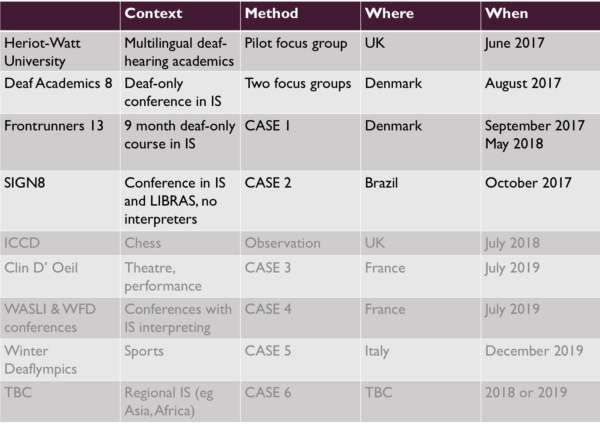 During the first year of my research on IS (May 2017-May 2018) I mostly focused on settings where IS is used in direct communication, in presentations and in teaching sessions, without the presence of interpreters (although people do engage in language brokering in these settings, informally interpreting for each other). I organised interviews and group discussions, and made use of visual methodologies: language portraits, participatory filmmaking, and discussion of an ethnographic film.
During the first year of my research on IS (May 2017-May 2018) I mostly focused on settings where IS is used in direct communication, in presentations and in teaching sessions, without the presence of interpreters (although people do engage in language brokering in these settings, informally interpreting for each other). I organised interviews and group discussions, and made use of visual methodologies: language portraits, participatory filmmaking, and discussion of an ethnographic film.
My next step was engaging in two case studies, accompanied by a camera team, since we are making an ethnographic film on IS, to be released in 2020. The aim of the film is to show how IS works, what people say it is, and how it is experienced. The film will contain 5 or 6 cases/locations recorded all over the world. Case 1 was the Frontrunners13 group in Denmark, and Case 2 the SIGN8 conference in Florianopolis. Next on our list are the Winter Deaflympics (a sports event), Clin D’Oeil (a cultural festival), and the quadrennial conferences of the World Federation of the Deaf and the World Association of Sign Language Interpreters in 2019, after which we will work on the final draft of the film. I work with two deaf cameramen from Belgium (from the company Visual Box). We collaborate smoothly since Jorn Rijckaert (the editor and head cameraman) understands my research interests very well (having edited my previous film Ishaare: Gestures and Signs in Mumbai). He also is fluent in IS himself which is very important when making decisions on where to train the camera. Also, three pairs of eyes see much more than one, and it was great to exchange observations and thoughts, which I captured in field notes.
One conference, two conference languages, no interpreters
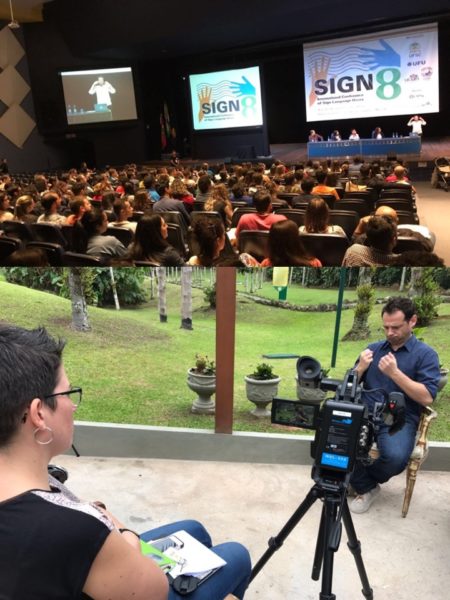 In Florianopolis, Brazil, at the SIGN8 conference in October 2017, no sign language interpreters were present, as per the conference language policy. Presentations could either be in IS or in Libras (Brazilian Sign Language) and the majority of participants and presenters were deaf people from Brazil, with also groups from Uruguay and Chile, and about 15 people who were not from South America. Pre-conference workshops on IS and Libras were organized, and the one on IS was attended by over 120 people, most of them Brazilians. During the workshop, some standard IS lexicon was taught, but the teachers also focused on passing on strategies and tips for international communication. During the conference, presenters tried their best to adapt to the international audience, and there were many instances of people engaging in brokering (informal interpreting for each other), during presentations and breaks alike. We filmed people’s communication strategies in platform presentations, poster presentations and workshops (several of them were not only in IS but also about IS!).
In Florianopolis, Brazil, at the SIGN8 conference in October 2017, no sign language interpreters were present, as per the conference language policy. Presentations could either be in IS or in Libras (Brazilian Sign Language) and the majority of participants and presenters were deaf people from Brazil, with also groups from Uruguay and Chile, and about 15 people who were not from South America. Pre-conference workshops on IS and Libras were organized, and the one on IS was attended by over 120 people, most of them Brazilians. During the workshop, some standard IS lexicon was taught, but the teachers also focused on passing on strategies and tips for international communication. During the conference, presenters tried their best to adapt to the international audience, and there were many instances of people engaging in brokering (informal interpreting for each other), during presentations and breaks alike. We filmed people’s communication strategies in platform presentations, poster presentations and workshops (several of them were not only in IS but also about IS!).
We did nine interviews with conference organisers, participants, and presenters about IS presenting strategies. We did a workshop on IS, gathering perspectives about IS in South-America and the role of contact with Europeans since many participants rather learned IS from visitors to their country rather than by travelling abroad. The SIGN conference series has a very different atmosphere in comparison to conferences with a majority of hearing participants: there is a strong ethos of adapting and connecting directly to the audience. In Florianopolis, non-native Libras signers tried to use Libras and Brazilians tried to use IS. Powerpoints were either in English, Portuguese or a mix of both (eg in English with some key terms in Portuguese or the other way around). A number of participants felt limited by linguistic barriers and wished there had been interpreters. At the same time the atmosphere was warm, friendly, open and characterized by direct communication, and many participants felt that their IS comprehension (and to a lesser extent production) had improved drastically by the end of the conference.
IS as esoteric language?
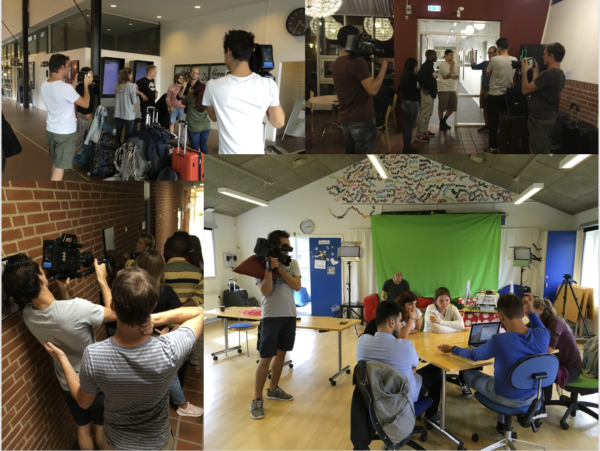 In September 2017 we filmed the arrival of the second batch of 17 new Frontrunners, constituting the 13thinception of this programme. Frontrunners is an international deaf education course, where the language policy mandates IS and written English. The first week of the new group was the perfect setting to observe and film the early stages of IS use in a group where only some of them were already fluent. We recorded how people communicated, rephrasing or explaining when the other did not understand, brokered, and proffered spontaneous remarks about their experience of this communication process (see the two last videos below for examples). Frontrunners13 travelled from Brazil, Jordan, Togo, South Korea, Belgium, France, Denmark, Spain, Ireland, Norway, Italy, Czech Republic and USA. It was challenging to do to this kind of data collection when so many conversations were going on simultaneously but we caught lots of very good examples on camera (and in pages and pages of field notes too). We elicited data for linguistic analysis of IS for Dr. Jordan Fenlon, a sign linguist (also deaf) by showing a Tweety & Sylvester cartoon and asking them to narrate it, and by eliciting a series of frequently used signs. I also did individual interviews about perspectives on IS with 10 Frontrunners and 2 teachers. The last day, I organized a group discussion on IS, on the same themes as the earlier organized focus groups.
In September 2017 we filmed the arrival of the second batch of 17 new Frontrunners, constituting the 13thinception of this programme. Frontrunners is an international deaf education course, where the language policy mandates IS and written English. The first week of the new group was the perfect setting to observe and film the early stages of IS use in a group where only some of them were already fluent. We recorded how people communicated, rephrasing or explaining when the other did not understand, brokered, and proffered spontaneous remarks about their experience of this communication process (see the two last videos below for examples). Frontrunners13 travelled from Brazil, Jordan, Togo, South Korea, Belgium, France, Denmark, Spain, Ireland, Norway, Italy, Czech Republic and USA. It was challenging to do to this kind of data collection when so many conversations were going on simultaneously but we caught lots of very good examples on camera (and in pages and pages of field notes too). We elicited data for linguistic analysis of IS for Dr. Jordan Fenlon, a sign linguist (also deaf) by showing a Tweety & Sylvester cartoon and asking them to narrate it, and by eliciting a series of frequently used signs. I also did individual interviews about perspectives on IS with 10 Frontrunners and 2 teachers. The last day, I organized a group discussion on IS, on the same themes as the earlier organized focus groups.
We returned for a week in May 2018, this time with Jordan in the team too. The aim was to see if and how their IS had changed in the eight months spent together, and if language convergence happened amongst the students. Jordan repeated the same linguistic elicitation task as September. Jordan then showed the results of the same task recorded in September, upon which he asked the participants to reflect on the differences. This elicited data will then be cross-checked with interview data and spontaneous data. Jordan also asked a few more questions, asking why people signed particular signs differently than in September. Explanations vary from: “this is not the sign used in this group”, “I learned those signs online before coming to Frontrunners but they are actually not used here”, “we discussed this sign in class and decided to use that one”, “this the Catalan sign ‘agree’ and we find it much clearer than the ASL sign for example”, “I really do not use just one sign per concept but adapt according to context, having expanded my repertoire here”.
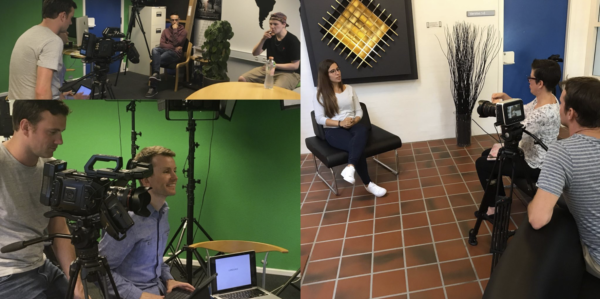
From then to now: Changes in IS practices and ideologies
After the elicitation task, I showed the Frontrunners students the 10-15 minute interviews I did with them in September 2017 (about the nature of IS, ASL in IS, the role of fingerspelling and mouthings in IS, etc). They then reflected on their own IS signing in the September video and on what they said back then. Examples: “I now understand that English is not essential for IS, contrary to what I thought before”, “Oh, I used a lot of ASL, and now I don’t, because people here told me not to, and I can better separate ASL from IS now”, “Now I feel IS is like my language, back then it wasn’t, even though I could sign in IS”, “Back then, I found fingerspelling in English incredibly hard and it’s still like that even though I expected I would significantly improve my English here”, “While in September I thought IS was 60% ASL, now I don’t think that anymore”, “I thought abundant facial expressions are absolutely central to IS but now I think that’s not necessarily the case”. Since we are not only gathering data for research but also for a film, these interviews were recorded in exactly the same spot as September, but to the right side in the same frame (in September they sat on the left). This way Jorn from Visual Box can edit the film we are creating in a way that shows change in signing and change in ideologies.
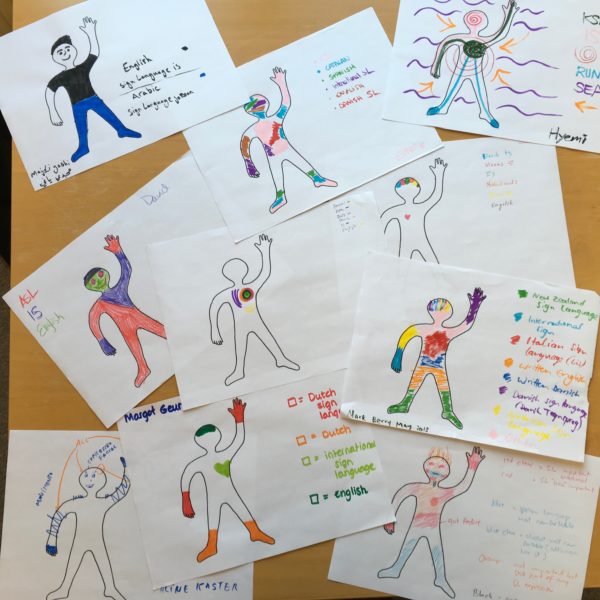 IS in the head, heart, hands, or feet: Language portraits
IS in the head, heart, hands, or feet: Language portraits
Another method I used that week in May is that of doing “language portraits”. These language portraits were done after the linguistic elicitation and the retrospective interviews, as the icing on the cake. Participants were given free rein to fill in an empty outline of a person with different colours, to explain how they link their different languages or different ways of communication to their bodies. The language portraits were very different from each other. Eg people coloured International Sign as pink “because it is beautiful”; as purple “because it is powerful” or associated with feminism. International Sign was located in the head, hands, feet or heart (or combinations); in different kinds of spatial and embodied relationships to other languages. International Sign was seen as closely related to English or ASL, and/or as part of a wider phenomenon of language mixing, translanguaging. Not only the language portraits in themselves are treated as data, but also the narratives that are related to the portraits. Different experiences such as enjoyment, working hard to learn a language, learning the language of a new partner, and distress were included in the narratives. The narratives that followed after working on the portraits definitely led to new insights in how people perceive and experience International Sign in relation to their bodies and in relation to the other languages or other forms of communication that are important for them. Before trying this method, I was uncertain about how useful it would be, but I’m very pleased with the result.
Recording oneself and being screened: participatory video and ethnographic film
During that week in May, I also used participatory video as a method, which means participants creating one or more films themselves. Five students of the Frontrunners group who were studying in the Frontrunners “media” strand created two short clips on my request (see below). I had asked them to make videos about what IS is, how it is experienced, and how IS has changed in this Frontrunners group. The two clips they came up with provoked discussion. Again, as with the language portraits, it is not just these creations that are interesting to analyse, but also the brainstorming in advance of creating the clips on Monday (which was recorded as well), and the lively discussion that followed in the Frontrunners group when the clips (see below) were showed on Friday. People discussed how the two short films did or did not correspond to their experience of IS. For example, IS was showed as a party, and we discussed how this represented the feeling of joy after having reached understanding.
The two videos created by Frontrunners students (click CC for English subtitles)
After this discussion we showed a 35-minute film that Jorn (Visual Box) had edited, based on the recordings of interactions and interviews made in September. We had shown this to the teachers already in the previous days, and it was followed by around 3 hours of interviews in total. When we showed this montage to the group it led to many laughs and surprised (and sometimes embarrassed) faces. Afterwards, people reflected on change of signing in the group, and on the utterances in the film, constantly referring to the concrete examples in the film. They talked about the use of fingerspelling (now less used in general), mouthings (some people still use mouthings from other languages eg Portuguese and French), ASL (it was said that ASL is used less in some contexts and by some people, but also more in other occasions). They reflected on the question of who influences IS use in the group and if there is a particular “Frontrunners 13 IS” (the answer is: yes and no). They also explained that in the first three months of Frontrunners, there was a lot of awareness about language use and that their awareness about ASL use had increased. Yet it happened more often in the last three months that people used signs that were easiest and quickest to use (which often meant using ASL signs), rather than adopting a signing style they highly valued (such as signing “more visually” – and it was discussed what it means to sign “more visually” too). This again led to a lively and in-depth discussion reflecting on changes in signing styles, and changes in language attitudes compared to September.
Two short excerpts from the video created by Visual Box (click CC for English subtitles)
I had a list of themes and questions I wanted to cover but I haven’t used it even once. I just sat, observed, and enjoyed the rich discussion that unfolded before my eyes. Participatory video and ethnographic film do wonders not only to help people reflect, but also for them to have a discussion totally on their own terms, yet without going off-topic. Certain themes that were covered in-depth were themes I had not put on my list of questions, but which were central for the IS experience of the Frontrunners, such as brokering in IS (for each other) in the classroom.

What’s next?
What struck me during the past year is that participants are usually very engaged in the workshops, the language portraits, the film discussions, the looking back on their own interviews; saying they learned a lot by seeing different perspectives on IS and in the case of Frontrunners, by seeing their own and others’ perspectives change. Clearly, the use and experience of IS is a theme that is very central to the experience of deaf people who are internationally mobile, in terms of connection and opportunities but also in terms of feeling limited and oppressed in linguistic and cultural terms.
While in the past year I have done research in contexts that were academic or focused on learning, and mostly deaf-only, in the next year I will focus on IS in sports and performance contexts, on historical differences in IS, and on IS interpreting. In year 3 I plan to focus on social media and online contexts. In the meantime, I started analyzing the data that I gathered, in a programme called Atlas.ti. I have created 1800 codes already and in the respect of analysis, this is already by far the most extensive and complicated project I have ever undertaken, and I’m not even halfway through! From the Fall of 2018 onwards, you can expect a series of blogs in which I share insights from analysis. Watch this space!







